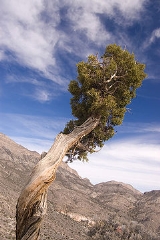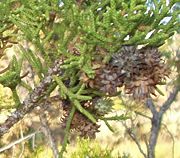
Juniperus osteosperma
Encyclopedia
Juniperus osteosperma is a shrub
or small tree
reaching 3-6 m (rarely to 9 m) tall. It is native to the southwestern United States
, in Utah
, Nevada
, Arizona
, western New Mexico
, western Colorado
, Wyoming
, southern Montana
, southern Idaho
and eastern California
. It grows at moderate altitudes of 1,300-2,600 m, on dry soils, often together with Pinus monophylla
.
 The shoots are fairly thick compared to most juniper
The shoots are fairly thick compared to most juniper
s, 1.5-2 mm diameter. The leaves
are arranged in opposite decussate pairs or whorls of three; the adult leaves are scale-like, 1-2 mm long (to 5 mm on lead shoots) and 1-1.5 mm broad. The juvenile leaves (on young seedling
s only) are needle-like, 5-10 mm long. The cones
are berry-like, 8-13 mm in diameter, blue-brown with a whitish waxy bloom, and contain a single seed
(rarely two); they are mature in about 18 months. The male cones are 2-4 mm long, and shed their pollen
in early spring. It is largely monoecious
with both sexes on the same plant, but around 10% of plants are dioecious
, producing cones of only one sex.
 The plants frequently bear numerous gall
The plants frequently bear numerous gall
s caused by the Juniper Tip Midge Oligotrophus betheli (Bibionomorpha
: Cecidomyiidae
); these are conspicuous pale violet-purple, produced in clusters of 5-20 together, each gall 1-2 cm diameter, with dense modified spreading scale-leaves 6-10 mm long and 2-3 mm broad at the base. Seeds are dispersed by Jackrabbits (mostly the Black-tailed Jackrabbit Lepus californicus spp.) rodent
s and to a lesser extent by coyote
s (Canis latrans).
Shrub
A shrub or bush is distinguished from a tree by its multiple stems and shorter height, usually under 5–6 m tall. A large number of plants may become either shrubs or trees, depending on the growing conditions they experience...
or small tree
Tree
A tree is a perennial woody plant. It is most often defined as a woody plant that has many secondary branches supported clear of the ground on a single main stem or trunk with clear apical dominance. A minimum height specification at maturity is cited by some authors, varying from 3 m to...
reaching 3-6 m (rarely to 9 m) tall. It is native to the southwestern United States
United States
The United States of America is a federal constitutional republic comprising fifty states and a federal district...
, in Utah
Utah
Utah is a state in the Western United States. It was the 45th state to join the Union, on January 4, 1896. Approximately 80% of Utah's 2,763,885 people live along the Wasatch Front, centering on Salt Lake City. This leaves vast expanses of the state nearly uninhabited, making the population the...
, Nevada
Nevada
Nevada is a state in the western, mountain west, and southwestern regions of the United States. With an area of and a population of about 2.7 million, it is the 7th-largest and 35th-most populous state. Over two-thirds of Nevada's people live in the Las Vegas metropolitan area, which contains its...
, Arizona
Arizona
Arizona ; is a state located in the southwestern region of the United States. It is also part of the western United States and the mountain west. The capital and largest city is Phoenix...
, western New Mexico
New Mexico
New Mexico is a state located in the southwest and western regions of the United States. New Mexico is also usually considered one of the Mountain States. With a population density of 16 per square mile, New Mexico is the sixth-most sparsely inhabited U.S...
, western Colorado
Colorado
Colorado is a U.S. state that encompasses much of the Rocky Mountains as well as the northeastern portion of the Colorado Plateau and the western edge of the Great Plains...
, Wyoming
Wyoming
Wyoming is a state in the mountain region of the Western United States. The western two thirds of the state is covered mostly with the mountain ranges and rangelands in the foothills of the Eastern Rocky Mountains, while the eastern third of the state is high elevation prairie known as the High...
, southern Montana
Montana
Montana is a state in the Western United States. The western third of Montana contains numerous mountain ranges. Smaller, "island ranges" are found in the central third of the state, for a total of 77 named ranges of the Rocky Mountains. This geographical fact is reflected in the state's name,...
, southern Idaho
Idaho
Idaho is a state in the Rocky Mountain area of the United States. The state's largest city and capital is Boise. Residents are called "Idahoans". Idaho was admitted to the Union on July 3, 1890, as the 43rd state....
and eastern California
California
California is a state located on the West Coast of the United States. It is by far the most populous U.S. state, and the third-largest by land area...
. It grows at moderate altitudes of 1,300-2,600 m, on dry soils, often together with Pinus monophylla
Single-leaf Pinyon
The Single-leaf Pinyon, ', is a pine in the pinyon pine group, native to the United States and northwest Mexico. The range is in southernmost Idaho, western Utah, Arizona, southwest New Mexico, Nevada, eastern and southern California and northern Baja California.It occurs at moderate altitudes from...
.

Juniper
Junipers are coniferous plants in the genus Juniperus of the cypress family Cupressaceae. Depending on taxonomic viewpoint, there are between 50-67 species of juniper, widely distributed throughout the northern hemisphere, from the Arctic, south to tropical Africa in the Old World, and to the...
s, 1.5-2 mm diameter. The leaves
Leaf
A leaf is an organ of a vascular plant, as defined in botanical terms, and in particular in plant morphology. Foliage is a mass noun that refers to leaves as a feature of plants....
are arranged in opposite decussate pairs or whorls of three; the adult leaves are scale-like, 1-2 mm long (to 5 mm on lead shoots) and 1-1.5 mm broad. The juvenile leaves (on young seedling
Seedling
thumb|Monocot and dicot seedlingsA seedling is a young plant sporophyte developing out of a plant embryo from a seed. Seedling development starts with germination of the seed. A typical young seedling consists of three main parts: the radicle , the hypocotyl , and the cotyledons...
s only) are needle-like, 5-10 mm long. The cones
Conifer cone
A cone is an organ on plants in the division Pinophyta that contains the reproductive structures. The familiar woody cone is the female cone, which produces seeds. The male cones, which produce pollen, are usually herbaceous and much less conspicuous even at full maturity...
are berry-like, 8-13 mm in diameter, blue-brown with a whitish waxy bloom, and contain a single seed
Seed
A seed is a small embryonic plant enclosed in a covering called the seed coat, usually with some stored food. It is the product of the ripened ovule of gymnosperm and angiosperm plants which occurs after fertilization and some growth within the mother plant...
(rarely two); they are mature in about 18 months. The male cones are 2-4 mm long, and shed their pollen
Pollen
Pollen is a fine to coarse powder containing the microgametophytes of seed plants, which produce the male gametes . Pollen grains have a hard coat that protects the sperm cells during the process of their movement from the stamens to the pistil of flowering plants or from the male cone to the...
in early spring. It is largely monoecious
Plant sexuality
Plant sexuality covers the wide variety of sexual reproduction systems found across the plant kingdom. This article describes morphological aspects of sexual reproduction of plants....
with both sexes on the same plant, but around 10% of plants are dioecious
Plant sexuality
Plant sexuality covers the wide variety of sexual reproduction systems found across the plant kingdom. This article describes morphological aspects of sexual reproduction of plants....
, producing cones of only one sex.

Gall
Galls or cecidia are outgrowths on the surface of lifeforms caused by invasion by other lifeforms, such as parasites or bacterial infection. Plant galls are abnormal outgrowths of plant tissues and can be caused by various parasites, from fungi and bacteria, to insects and mites...
s caused by the Juniper Tip Midge Oligotrophus betheli (Bibionomorpha
Bibionomorpha
Bibionomorpha is an infraorder of Nematocera. One of its constituent families, the Anisopodidae, is the presumed sister taxon to the entire suborder Brachycera. Several of the remaining families in the infraorder are former subfamilies of the Mycetophilidae, which has been recently subdivided...
: Cecidomyiidae
Cecidomyiidae
Cecidomyiidae is a family of flies known as gall midges or gall gnats. As the name implies, the larvae of most gall midges feed within plant tissue, creating abnormal plant growths called galls.These are very fragile small insects usually only 2–3 mm in length and many are less than...
); these are conspicuous pale violet-purple, produced in clusters of 5-20 together, each gall 1-2 cm diameter, with dense modified spreading scale-leaves 6-10 mm long and 2-3 mm broad at the base. Seeds are dispersed by Jackrabbits (mostly the Black-tailed Jackrabbit Lepus californicus spp.) rodent
Rodent
Rodentia is an order of mammals also known as rodents, characterised by two continuously growing incisors in the upper and lower jaws which must be kept short by gnawing....
s and to a lesser extent by coyote
Coyote
The coyote , also known as the American jackal or the prairie wolf, is a species of canine found throughout North and Central America, ranging from Panama in the south, north through Mexico, the United States and Canada...
s (Canis latrans).

